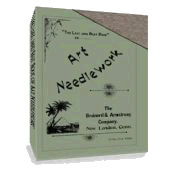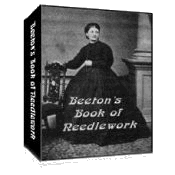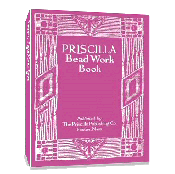Victorian Drapery
(continued)
MOST of the Victorian Drapery of which we have spoken (see Victorian Drapes) are deep in color and substantial in material, while the decoration is mainly light upon a darker ground. Besides this more massive style, a great variety of beautiful hangings are designed on an opposite principle; the ground is light and the ornament is dark. The pattern should not be very massive and heavy for this kind of work, or it will look too substantial for the ground, and also this kind of curtain will be used where a somewhat light decoration is required; for a drawing-room in the richer materials, and for a morning-room, boudoir, or bedroom in the simpler ones.
Several kinds of satin are made for this purpose in beautiful creamy tints, which take embroidery in filosel extremely well. There are also numerous waste silk fabrics which hang and wear well, and are inexpensive; the lighter colors in these are very good, and the work is pleasant to do. There is no better material than linen sheeting for curtains, unbleached if possible: twilled and diapered linen is also very good. Linen will take filosel, and is good enough in itself for careful work, being the most durable of all our materials. The browner kinds also make good curtains
Cotton sheeting makes pretty and inexpensive curtains, and its color and softness recommend it much, but if you are going to take much pains with your curtains and put a good deal of work upon them, a silk or linen material is much better. These light-colored materials look best with a pattern that covers them all over, though it need not be an elaborate one. Such patterns as Figs, 1, 6, and 6a (see below) look very well in one color, and may be worked in filosel, or in crewel or some thicker kind of worsted.

Victorian Drapery
Fig. 1. — Spray for Outline. Poppies
Click on picture to see more detail.
Queen Anne Style Drapery
Beautiful curtains in a Queen Anne style and adapted from old work of her time, are done in large flowers in outline, with the ground darned in lines, which look all the better for some irregularity both in the length of the stitches and the closeness of the lines. The color of this sort of work is variously managed. It looks well in monochrome, ground and flowers alike; a fine set has been done with the flowers in dull yellow with the darning in dull blue. Another curtain has the flowers of a deep greenish blue, with the ground darned in the dull or broken yellow; and a third which has a handsome leaf pattern in blue has the darning in slightly varying shades of yellow.
Victorian Drapery
Fig. 6. — Curtain with Darned Ground. Queen Anne.
Click on picture to see more detail.
Early 18th Century Drapery
For more varied colors, chintzes of the early part of this century will give good suggestions of pattern. A light pattern of carnations running over the whole looks very well, the flowers in several shades of red and red-pink, and the leaves and stalks in one, or at most two, shades of green. This would be dainty enough for silk, or would suit fine linen, with the work in silk (see Fig. 6a, above).17th Century Drapery
In the seventeenth century a good many curtains seem to have been worked on linen in bright colored crewels, the colors being in such numbers and varieties as to harmonize each other into a true polychrome. The patterns are usually large or middle-sized leaves and flowers, in the older and better specimens much conventionalized; they spread all over the curtain in a good proportion of ornament and ground, and the branches grow from one or more stems, which in their turn grow from three or more rows of a scale-like arrangement which is a conventional mode of expressing the green earth. The transferred curtain is of this kind. They are not very suitable for reproduction, but they give a good example of polychrome work. Their patterns will sometimes furnish a good design for working in one color, the flowers and leaves being filled with a sufficient quantity of stitches to give them weight and fullness.
Victorian Drapery
Fig. 6a. — An Old Embroidered Curtain. French.
Click on picture to see more detail.
Mediaeval Style Drapery
For a room that will bear a mediaeval style of curtain, and that is not too large or stately for a fanciful device, very effective and interesting curtains can be made like that in Fig. 7 below, which was suggested by some dating from the seventeenth century. The ground is blue cloth or serge — dark blue linen might also be used; the motto is repeated again and again, until the spaces are filled, leaving off, if necessary, in the middle of a word. The letters are made in linen tape, unbleached, the yellowier the better, and the heraldic creatures, which should be as many and various as possible, are applied in white cloth, serge, linenor any suitable material, and marked out with blue crewel, or with crewel of their “proper” colors.
Victorian Drapery
Fig. 7. — A Heraldic Curtain.
Click on picture to see more detail.
Tape will lend itself well to the forming of mediaeval letters of the best style; it must be well sewn down, and the letters kept close together; the lines must be bordered with the tape and the ornament must be proportioned to the size of the curtain, which could not be done in the illustration, where scale has been sacrificed to clearness.
Victorian Drapery for Curtained Beds
Curtained beds are now so little used that to speak of furniture for them may be less interesting than our other subjects. Yet as there are curtained beds in many of our houses that have not been very newly furnished and the prejudice in favor of them has not yet quite died out, we will devote a few words to what used to be a triumph of the needlewoman’s art. In Lacroix’s Arts of the Middle Ages, page 19, is an embroidered bed of the fourteenth century as shown in a miniature, which is worthy of study from its completeness and from the good suggestion it gives for modern embroidery. The ornament is mainly composed of intertwined branches of two plants, possibly the owner’s badge, one with small leaves and the other with larger and rounder ones. These form a very broad stripe which is carried diagonally across the curtain (there is but one, drawn across the foot of the bed,) and it is taken also diagonally across the coverlet. At the bed’s head is the owner’s crest, a talbot with collar and chain, branches of the two plants are right and left of him. On the valance round the top of the bed is the motto, “Jamais, Jamais,” repeated all round, with a short fringe beneath it. This is a good model and very easy to follow; it can be adapted to a bed where very little drapery is used, and window curtains, a portiere, or a wardrobe-hanging worked to correspond.
Victorian Drapery
Fig. 8. — Border. Old English.
Click on picture to see more detail.
A bedroom at Hardwick Hall, Derbyshire, is furnished throughout with hangings on which a beautiful circular flower, Fig. 18 (see figure to left), is formed into circles, diamonds or borders for the centers and edges of the coverlet, bed head, valances, bed and window curtains, and a hanging for the toilet table, all worked in deep lilac silk on white twill. This might be adapted to the needs of a modern bedroom with a dainty effect, rendering the room more interesting and its furniture more really valuable than could be done with the most expensive upholstery.
Victorian Wall Hangings
Victorian Wall Hangings are sometimes embroidered to cover all or part of the walls of a room. We do not very much recommend them, as for the great majority of our rooms paint or paper make much better wall decorations than hangings, both being, and looking, much cleaner and fresher. Pictures, furniture, and all the multitude of things that occupy a modern room and make it to differ so much from the scantily furnished rooms of our ancestors, interfere much with the effect of a continuous hanging round a room. If the walls are to be hung with a textile fabric at all, it should be either of such a nature that to have parts of it hidden is not too great a sacrifice, or it should be the main decoration of the room, as in the case of tapestry. A kind of needlework tapestry has been sometimes of late attempted for hangings, but it is an exceptional work, requiring much labor and designs of the nature of picture cartoons.If a wall hanging be particularly desired, the most repaying will be a narrow frieze-like hanging above a dado, of a width proportioned to it, and worked with stiff upright stems of flowers highly conventionalized, or such a pattern as Fig, 5 (see figure below), or, at even distances, pots in outline with a group of flowers of one sort in each pot. Fig. 5 was sketched from some old Sicilian work about twenty inches wide, which had apparently been used for this very purpose. The groups might be further varied by keeping the arrangement and altering the flowers.

Victorian Drapery
Fig. 5. — Border. Old Sicilian Work.
Click on picture to see more detail.
Another plan is to take a running frieze-like pattern in the cinque-cento style all round the room; it might be mixed with birds, heraldic beasts, or Amorini*.
A more mediaeval style might have a procession of figures in the style of those in Strutt’s Sports and Pastimes, playing at different games, hunting, running, &c. Figures, however, require very cautious management.
The advantage of this sort of decoration is that it can be taken down and kept in safety when the room is out of use, or it can be readily transferred from one room to another.
With regard to the color of all these various hangings, it is difficult, if not impossible, to give any useful directions, for while shades and tones are infinite, words are very few, and, in this matter, very inexpressive. Even if the coloring of a single curtain could be explained, only half the work would be done, for the surroundings must have their share of attention, and a curtain that will be beautiful in one room will be ugly in another.
Victorian Drapery and Color
Several good arrangements of color have already been named. Harmonies in shades of one color are usually successful, especially in golden browns and reds. If all the colors are used together they harmonize each other, as we see in Indian and other polychrome work. Two or three colors require great circumspection to get them right, for all combinations depend very much on the shade and tone of each, and all pre-suppose a skill in coloring that is in part a gift, but in part also the result and reward of study and experience.When someone who thought such secrets might be told in a word, asked Sir Joshua Reynolds with what medium he mixed his colors, the painter replied, “With brains, sir.” So it is with this as with all things pertaining to art; without “brains” no directions are of much avail, and with them a hint is enough.

Victorian Drapery
Fig. 9. — Spray. Sir Joshua Reynolds.
Click on picture to see more detail.
Such a costly and laborious work as a set of curtains is worth much consideration, and the taking of capable advice, to save the worker from having to pass long years in the constant contemplation of a mistake, to correct which, time, money, or energy may be lacking.
*A depiction of a cherubic infant, often shown winged represented as an infant cupid.
If you don't have time or feel making your own Victorian draperies are beyond your skill set, you can always purchase some that will fit your needs. Take a look below:
For more information, illustrations, and designs for Victorian Drapery, see the following pages:
Drapery, Page 1. Drapery, Page 2. Victorian Portieres.
Return to top of Victorian Drapery page.
Return to Victorian Home Decor page.
Return from Victorian Draperies page to Home.



 433 pages!
433 pages!

